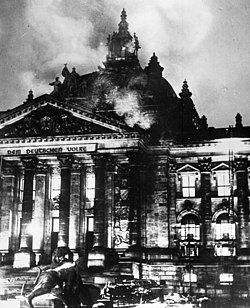| | |
| Operational area | |
|---|---|
| Country | |
| City | |
| Agency overview | |
| Established | 1 February 1851 |
| Annual calls | 478,281 (2019) |
| Employees | 4,479 (2019) |
| Fire chief | Dr. Karsten Homrighausen |
| Motto | Wir retten Berlin. Seit 1851. (lit. We save Berlin. Since 1851.) |
| Website | |
| www.berliner-feuerwehr.de | |



The Berlin Fire Brigade (German : Berliner Feuerwehr - Berlin Fire Defence) is the fire and emergency medical service for Berlin, Germany. As well as firefighting, the Berlin Fire Brigade provides fire prevention, technical rescue services, emergency medical services, and assistance in case of chemical, biological, radioactive and nuclear hazards. (CBRN defense)
Contents
- History
- Industrialization and Wilhelminian period (1851-1899)
- Turn of the century, First World War and Weimar Republic (1900-1932)
- National Socialism (1933-1945)
- One city - two fire brigades (1946-1990)
- Development since reunification
- Fire Chiefs
- Special Operations
- Legal basis and organization
- Museum
- Training and Education
- Structure
- Fire Stations
- Volunteer Fire Stations
- Equipment and Vehicles
- Berlin Concept "LHF": Fire Engine with comprehensive technical equipment
- Ambulance
- City partnership
- See also
- References
The brigade was officially formed on February 1, 1851, by Ludwig Scabell, under the command of King Frederick William IV. Since August 2018, the Berlin Fire Brigade is under the command of its Fire Chief, State Fire Director Dr. Karsten Homrighausen. [1] Landesbranddirektor, short LBD, translates in German to State Fire Director.
The Berlin Fire Brigade is the oldest and largest municipal fire brigade in Germany. It has a total of 4,479 staff, [2] including 4,082 operational firefighters and officers based at 35 main fire stations. [3] It is supported by an additional 1,537 volunteer firefighters based at 59 volunteer fire stations. [3] Freiwillige Feuerwehr - "Free Willing Fire Defence" is the term used for Volunteer Fire Stations. The Berlin Fire Brigade has an annual budget of around €250,000,000, which includes personnel costs and investments. [2]
In 2019, Berlin Fire Defence received 478,281 emergency calls. It is the busiest of all fire services in Germany. Approximately 83% of the alarms per year are for the emergency services, 5% for technical assistance and only 2% for firefighting. [2]



